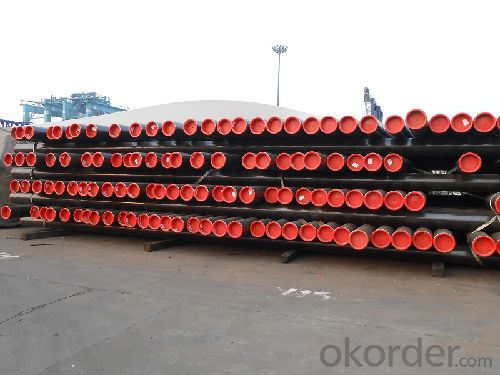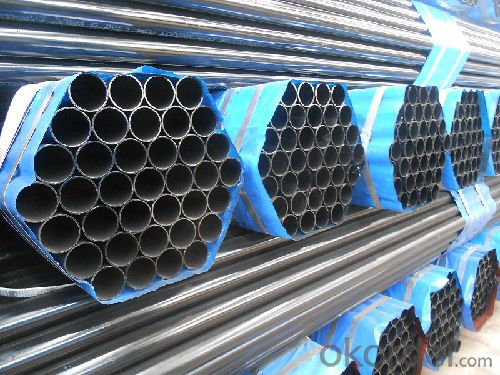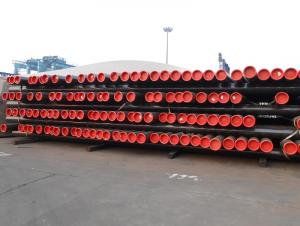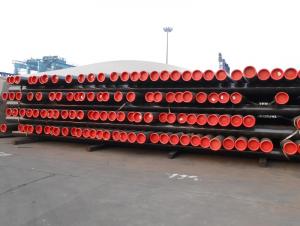High grade seamless steel pipe for petroleum
- Loading Port:
- Tianjin
- Payment Terms:
- TT or LC
- Min Order Qty:
- 40 m.t.
- Supply Capability:
- 15000 m.t./month
OKorder Service Pledge
OKorder Financial Service
You Might Also Like
1、Structure of High grade seamless steel pipe for petroleum :
Seamless pipe is formed by drawing a solid billet over a piercing rod to create the hollow shell. As the manufacturing process does not include any welding, seamless pipes are perceived to be stronger and more reliable. Historically seamless pipe was regarded as withstanding pressure better than other types, and was often more easily available than welded pipe.
2、Main Features of High grade seamless steel pipe for petroleum :
• High manufacturing accuracy
• High strength
• Small inertia resistance
• Strong heat dissipation ability
• Good visual effect
• Reasonable price
3、 High grade seamless steel pipe for petroleum Specification:
Standard | GB, DIN, ASTM ASTM A106-2006, ASTM A53-2007 |
Grade | 10#-45#, 16Mn 10#, 20#, 45#, 16Mn |
Thickness | 8 - 33 mm |
Section Shape | Round |
Outer Diameter | 133 - 219 mm |
Place of Origin | Shandong, China (Mainland) |
Secondary Or Not | Non-secondary |
Application | Hydraulic Pipe |
Technique | Cold Drawn |
Certification | API |
Surface Treatment | factory state or painted black |
Special Pipe | API Pipe |
Alloy Or Not | Non-alloy |
Length | 5-12M |
Outer Diameter | 21.3-610mm |
Grade | 20#, 45#, Q345, API J55, API K55, API L80, API N80, API P110, A53B |
Standard | ASME, ASTM |
1) Material:20#(ASTM A 106/A53 GRB.API5LGRB,GB),45#,16Mn,10#.
2) Specification range:OD:21.3-610mm,WT:6-70mm,length:6-12m or according to the requirement of clients.
3) Excutive standards:GB,ASME API5L.ASTM A 106/A53,Despite of the above standards,we can also supply seamless steel pipe with standard of DIN,JIS,and so on,and also develop new products according to the requirements of our clients!
4) Surface:black lacquered,varnish coating or galvanized.
5) Ends:Beveled or square cut,plastic capped,painted.
6) Packing:bundles wrapped with strong steel strip,seaworthy packing.
4、Packaging & Delivery
Packaging Details: | seaworthy package,bundles wrapped with strong steel strip |
Delivery Detail: | 15-30days after received 30%TT |
5、FAQ of High grade seamless steel pipe for petroleum :
①How is the quality of your products?
Our products are manufactured strictly according to national and internaional standard, and we take a test
on every pipe before delivered out. If you want see our quality certifications and all kinds of testing report, please just ask us for it.
Guaranteed: If products’ quality don’t accord to discription as we give or the promise before you place order, we promise 100% refund.
②How about price?
Yes, we are factory and be able to give you lowest price below market one, and we have a policy that “ for saving time and absolutely honest business attitude, we quote as lowest as possible for any customer, and discount can be given according to quantity”,if you like bargain and factory price is not low enough as you think, just don’t waste your time.Please trust the quotation we would give you, it is professional one.
③Why should you chose us?
Chose happens because of quality, then price, We can give you both.Additionally, we can also offer professional products inquiry, products knowledge train(for agents), smooth goods delivery, exellent customer solution proposals.Our service formula: good quality+good price+good service=customer’s trust
SGS test is available, customer inspection before shipping is welcome, third party inspection is no problem.
6、 High grade seamless steel pipe for petroleum Images:


- Q:Can steel pipes be used for chemical processing plants?
- Yes, steel pipes can be used for chemical processing plants. Steel pipes have excellent strength, durability, and resistance to corrosion, making them suitable for transporting various chemicals and fluids in a chemical processing plant. Additionally, steel pipes can withstand high temperatures and pressures, ensuring safe and efficient operations in such industrial settings.
- Q:What are the different types of supports used for aboveground steel pipes?
- There are several types of supports used for aboveground steel pipes, including pipe hangers, pipe shoes, pipe clamps, and pipe rollers. These supports are designed to provide stability, prevent sagging, and distribute the weight of the pipe evenly, ensuring the structural integrity of the system.
- Q:What does "HBB" glass steel pipe mean?
- Non electrical corrosion, non-magnetic, suitable for single core cable laying, and steel pipe is a magnetic material, special treatment must be taken to prevent the formation of eddy currents.
- Q:What are the different types of steel pipe elbows?
- There are several different types of steel pipe elbows that are commonly used in various industries and applications. These types include: 1. 90-degree elbows: These elbows have a sharp 90-degree bend and are commonly used when a change in direction is required to redirect the flow of fluid or gas. They are widely used in plumbing, construction, and industrial piping systems. 2. 45-degree elbows: Similar to 90-degree elbows, 45-degree elbows also provide a change in direction but with a smaller angle. They are often used in situations where a more gradual change in flow direction is required. 3. Long radius elbows: Long radius elbows have a larger radius of curvature compared to standard elbows. This design helps to reduce fluid friction and pressure drop, making them suitable for applications that require smoother flow, such as in high-flow systems or those involving viscous fluids. 4. Short radius elbows: In contrast to long radius elbows, short radius elbows have a smaller radius of curvature. They are generally used in tight spaces where a compact design is required, but they can cause higher pressure drops due to increased fluid friction. 5. Reducing elbows: These elbows are used when there is a need to connect pipes of different diameters. They have one end with a larger diameter and the other end with a smaller diameter, allowing for a smooth transition between two pipes of different sizes. 6. Mitered elbows: Mitered elbows are custom-made elbows that are fabricated by cutting and welding multiple sections of pipe at specific angles. They are often used in situations where standard elbows cannot accommodate the required angle or when a unique design is needed. Overall, the selection of the appropriate type of steel pipe elbow depends on factors such as the application, fluid flow requirements, space constraints, and compatibility with the piping system.
- Q:Are steel pipes suitable for HVAC systems?
- Yes, steel pipes are suitable for HVAC systems. Steel pipes have several advantages that make them a popular choice for HVAC applications. First, steel pipes are strong and durable, allowing them to withstand high pressure and temperature requirements commonly found in HVAC systems. Additionally, steel pipes have excellent corrosion resistance, making them suitable for both indoor and outdoor installations. Steel pipes also have a long lifespan, reducing the need for frequent replacements or repairs. Moreover, steel pipes are readily available in various sizes and thicknesses, allowing for easy customization and installation. Lastly, steel pipes are cost-effective, providing a cost-efficient solution for HVAC systems compared to other materials. Overall, steel pipes are a reliable and suitable choice for HVAC systems due to their strength, durability, corrosion resistance, availability, and cost-effectiveness.
- Q:What are the different methods of pipe joining using steel pipes?
- There are several methods of pipe joining using steel pipes, each with its own advantages and disadvantages. 1. Threaded and coupled: This method involves threading the ends of the steel pipes and using couplings to connect them. It is a simple and cost-effective method, but it is not suitable for high-pressure or gas applications. 2. Welding: Welding is a popular method for joining steel pipes. It involves heating the ends of the pipes and fusing them together using a welding process. This method creates a strong and leak-proof joint, but it requires skilled labor and can be time-consuming. 3. Grooved: In this method, the ends of the steel pipes are grooved and then connected using mechanical couplings or fittings. It is a quick and reliable method, suitable for both high-pressure and low-pressure applications. However, it requires specialized tools and equipment. 4. Flanged: Flanged joints involve connecting steel pipes using flanges, which are flat discs with bolt holes. The pipes are aligned and bolted together using gaskets to create a secure connection. This method is commonly used for large-diameter pipes and high-pressure applications, but it can be expensive and time-consuming to install. 5. Compression: Compression fittings are used to join steel pipes by compressing a ferrule or sleeve against the pipe. This method is quick, easy, and requires no special tools. However, it is not suitable for high-pressure or high-temperature applications. 6. Brazing: Brazing involves heating the ends of the steel pipes and melting a filler material between them to form a joint. It is a reliable method for joining pipes in HVAC and refrigeration systems, but it requires skilled labor and careful temperature control. It is important to consider the specific requirements of the application, such as pressure, temperature, and material compatibility, when selecting the appropriate method of pipe joining using steel pipes.
- Q:How are steel pipes used in the manufacturing of telecommunications infrastructure?
- Steel pipes are used in the manufacturing of telecommunications infrastructure to provide a sturdy and reliable framework for cables and wires. These pipes are commonly used for underground and overhead installations, ensuring protection and support for the necessary communication systems.
- Q:What are the common applications of steel pipes?
- Steel pipes have a wide range of common applications in various industries including oil and gas transportation, plumbing systems, structural support in construction, irrigation systems, and industrial processes such as water and wastewater treatment.
- Q:How do steel pipes handle chemical substances?
- Steel pipes are highly resistant to chemical substances due to their durability and corrosion resistance. The smooth interior surface of steel pipes prevents the accumulation of chemical deposits, ensuring minimal reaction with the substances being transported. Additionally, steel pipes can be coated or lined with protective materials to further enhance the resistance against specific chemicals, making them a reliable choice for handling various chemical substances.
- Q:What are the different types of coatings used for internal lining of steel pipes?
- There are several types of coatings commonly used for the internal lining of steel pipes, including epoxy coatings, polyurethane coatings, and cement mortar linings. These coatings are applied to protect the steel pipes from corrosion, improve the flow of fluids, and enhance the longevity and durability of the pipes.
1. Manufacturer Overview |
|
|---|---|
| Location | |
| Year Established | |
| Annual Output Value | |
| Main Markets | |
| Company Certifications | |
2. Manufacturer Certificates |
|
|---|---|
| a) Certification Name | |
| Range | |
| Reference | |
| Validity Period | |
3. Manufacturer Capability |
|
|---|---|
| a)Trade Capacity | |
| Nearest Port | |
| Export Percentage | |
| No.of Employees in Trade Department | |
| Language Spoken: | |
| b)Factory Information | |
| Factory Size: | |
| No. of Production Lines | |
| Contract Manufacturing | |
| Product Price Range | |
Send your message to us
High grade seamless steel pipe for petroleum
- Loading Port:
- Tianjin
- Payment Terms:
- TT or LC
- Min Order Qty:
- 40 m.t.
- Supply Capability:
- 15000 m.t./month
OKorder Service Pledge
OKorder Financial Service
Similar products
New products
Hot products
Related keywords






























